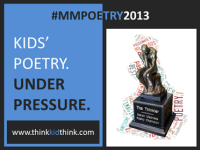plank bridge—
clinging for their lives
ivy vines
Basho
the harvest moon
I stroll round the pond
till the night is through
Basho
storm—chestnuts
race along
the bamboo porch
Shiki
The more time I spend reading and writing haiku, the more I am convinced of their incredible depth and of their value in today’s world.
Haiku are an ideal form for everyone–especially kids.
Why?
1. Haiku focus on a single intense moment in the present. Our current culture pushes us to rush from one thing to the next, while thinking about a multitude of other things. Haiku provide an opportunity to slow down, pay attention to now, and closely observe the world in front of us.
2. Haiku focus on the natural world and on our connections to the natural world. Yesterday we had record-breaking heat in Washington, DC after a strangely cool spring. Each day presents new evidence that we have damaged our planet. Now more than ever, we need to attend to the natural world and our connections to it.
3. Haiku require readers to actively participate in making meaning. Readers use the images from the poems to paint pictures in their heads. These pictures often include sounds, smells, textures, and tastes. Readers must infer the signficance of the images and their connections. Though haiku images are concrete and their words often plain, haiku are complex and their readers cannot be passive.
Unfortunately, I think most of us learn a very simple definition of haiku—a nature poem of 17 syllables in three lines—that misses its essential characteristics. There are many fabulous discussions of haiku written by more experienced students and writers, but instead of sending you away, I will give you my current understanding.
What are the essential characteristics of haiku?
1. Haiku are short. They are one moment, expressed in one breath. The Japanese poets who developed the form believed one breath was best expressed in 17 onji or sound symbols. Some poets who write haiku in English write them in 17 syllables. However onji are not exactly parallel to syllables, and to many 17 syllables feels like more than one breath. For this reason, many poets of haiku in English write poems of fewer syllables.
2. Haiku are traditionally three lines. Typically, one line (the first or third) presents a natural context: a plank bridge, the harvest moon, a storm. The other two lines describe something more: ivy vines clinging, a stroll round a pond, chestnuts racing along a porch. Sometimes the second line of the more includes a turn or surprise, such as a stroll round a pond that lasts the whole night. By connecting the two parts of the haiku, the reader experiences a moment of discovery or aha. Some haiku poets accomplish this in one line or four, using the line breaks as a tool of expression.
3. Haiku provide direct experience. They are written in the present tense. They do not use metaphor, simile, personification, or rhyme because that would interfere with the direct experience.
4. Haiku are about the interrelatedness of humans and nature. Often the human is there only as an attentive observer. Other times the human is represented implicitly by a verb requiring human action, such as lighting the lanterns. The human can also be represented by a pronoun such as I or me or my.
5. Haiku is not just a form of poetry. It is a way of being in the world.
I hope I’ve convinced you to give it a try. As with most things, it’s harder than it looks and worth the effort.
For more information:
The Haiku Society of America has a page of educational resources, which includes an introduction to haiku.
Jane Reichhold’s Bare Bones School of Haiku provides 14 lessons on haiku and how to write them.
Robyn Hood Black has written many beautiful haiku. On her website she provides a list of haiku resources and lesson plans for K-2 and grades 3 and up.
Diane Mayr posts lots of haiku “stickies” and other delectables on her blog Random Noodling.
Finally, this week I typed “haiku” into itunes search and discovered Haiku Chronicles podcasts. What a find! They have over 25 episodes dedicated to all things haiku. They delve into the history of the form in Japan and in the US. Some include old recordings of poets discussing and reading haiku. In the 8th episode Anita Virgil provides her 9 questions for judging haiku. She says most don’t make it past question 2!
For more Poetry Friday, visit, yes, Diane Mayr’s Random Noodling!
Come back on Tuesday, April 16th to see the 2013 Kidlitosphere Progressive Poem progress.
(c) 2013, Elizabeth Steinglass, all rights reserved












